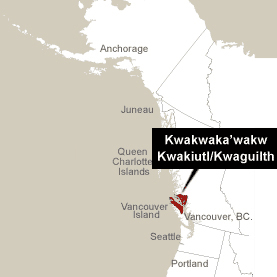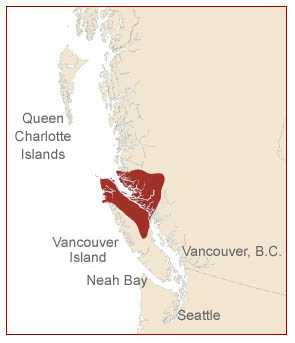
Situated on the northern part of Vancouver Island, British Columbia, Canada, the Kwakwaka’wakw tribal lands are a stunning union of forest, sea and mountains. This remarkable environment teeming with life fostered the dramatic art of this tribe.
Renowned for carving and considered the most theatrical of all of the northwest coast tribes, the Kwakwaka’wakw carving style is bold, with deep incisions. The hallmark bright colors characteristically combined with white paint highlight dramatic expressions intensifying the features in firelight dance performance.
Among the most recognized masks of the Kwakwaka’wakw are the massive Hamatsa bird masks: Crooked Beak, Huk-huk and Raven. Members of the Hamatsa Dance Society dance these three masks during the initiation ceremony of new Hamatsa Society members. This particular ceremony dramatizes the struggle of good and evil forces for the young initiate’s soul. The giant Hamatsa birds are the earthly representatives of Baxwbakwalanuxwsiwe’, the colossal cannibal spirit in the sky world. The enormous birds try to lure the young person into the dark realm, while the family and tribe work tirelessly to liberate the forces of evil from the young person’s soul. When the initiation ceremony concludes (which can take several days), the forces of good, with any luck, have prevailed and the young initiate is ready to be a productive, positive contributing member to the Hamatsa society and the tribe.
 The Kwakwaka’wakw observe the winter season as the ceremonial season. During this time, various ceremonies equally stunning as the Hamatsa Ceremony make full and dramatic use of the Kwakwaka’wakw mask tradition. Many masks transform from one character to another, demonstrating to the audience transformations that the dancer is undergoing.
The Kwakwaka’wakw observe the winter season as the ceremonial season. During this time, various ceremonies equally stunning as the Hamatsa Ceremony make full and dramatic use of the Kwakwaka’wakw mask tradition. Many masks transform from one character to another, demonstrating to the audience transformations that the dancer is undergoing.
Historically, the Kwakwaka’wakw have had an unbroken cultural legacy of carving despite outside oppression. In 1870, the Canadian Government enacted the “Potlatch Ban” which prohibited any native peoples from participating in traditional native ceremony. This was the beginning of a dark period of cultural prohibition, during which only a few determined carvers continued stealthily to create objects for ceremonial purposes. Their resolve not to surrender their traditional way of life in favor of embracing colonial religious customs insures that the sacred, spiritual life of the Kwakwaka’wakw would be preserved and passed down to future generations. The Canadian Government repealed the potlatch ban in 1951.
The museum collections at Chicago’s Field Museum, New York’s Museum of Natural History, the Seattle Art Museum and the University of British Columbia’s Anthropology Museum as well as Victoria’s Provincial Museum, hold vast, diverse collections of Kwakwaka’wakw carvings from the last two centuries. Ironically, many of these pieces were collected from the tribes during the time spanning the Potlatch Ban.
Today the carving tradition is flourishing; contemporary carvers look to renowned Mungo Martin and Bill James as sources of inspiration. Continued building of cultural centers and Longhouses on tribal lands on North Vancouver Island also help to maintain Kwakwaka’wakw cultural tradition. They offer visitors to the region an opportunity to gain a better understanding of Kwakwaka’wakw history and culture and the remarkable incorporation of art and ceremony into every facet of life.
Recommended reading*:
- Brown, Steve. Native Visions.
- Brown, Steve. Spirit Within.
- Hawthorn, Audrey. Kwakiutl Art.
- Holm, Bill. The Box of Daylight.
- Holm, Bill. Smokey Top: The Art and Times of Willie Seaweed.
- Holm, Bill. Spirit and Ancestor: A Century of Northwest Coast Indian Art at the Burke Museum.
- Jonaitus, Aldona. Chiefly Feasts.
- Wyatt, Gary. Spirit Faces.
*Books on this list may be out of print.
Copyright © M. Heagle
